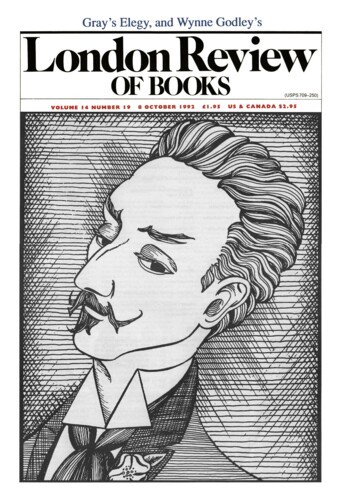A parable, an allegory, a moral fable, must convince us first on the literal level to have full effect in its symbolic message. In ‘The Metamorphosis’ and The Trial our attention is immediately engaged by the opening sentences that tell of Gregor Samsa’s transformation into a gigantic insect lying on its back and unable to turn over, and by the bald information that Joseph K. ‘without having done anything wrong was arrested one fine morning’. Animal Farm, similarly, is interesting first of all as a story about animals trying to run their own society without the interference of humans. Any visionary or satirical meaning is apprehended later, and in Kafka’s case its nature is still a matter for argument. A friend once called him the last Jesuit, and it has always seemed to me that the ultimate meaning of Kafka’s fictions is that the individual must – and should – lose his fight against society or God.
Whether any particular reading is ‘wrong’ or ‘right’ is much less important than that the parable should be capable of bearing it. Nor does it much matter if a later reading differs from that understood at the time of writing. When Kafka read the opening chapter of The Trial to friends in 1915 both he and they roared with laughter, but we are loaded with so much later knowledge that the idea of being arrested without reason doesn’t raise a smile. And in fifty years’ time when the Soviet Union is distant history Animal Farm is likely to survive without more exact reference than as a fable about social idealism spoiled (and of course as a charming fairy-tale), as The Pilgrim’s Progress is now no more than a piece of literature, remote from Bunyan’s passionate plea for a simple nonconformist Christianity.
The God-Fearer, like most of Dan Jacobson’s recent work, asks to be considered on both literal and symbolic levels. Kobus the Bookbinder, an old man living alone, his existence ‘not much more than a kind of postscript to a life that was already concluded’, is visited by two ghostly children, a girl of nine and a boy a couple of years younger. They do not speak to him, he is unable to touch them, but they wear the clothing of the Christer, ‘the followers of Yeshua, Jesus, the Christus, the Natzerit, whatever they liked to call him’.
Through the visitations of the children Kobus’s mind moves back to a decisive moment of betrayal in his youth as Kobus the Apprentice when Sannie, a Christer girl he knew, liked and even loved, was on trial for practising witchcraft. Kobus gave evidence at her trial, could have spoken in her defence, but feared to do so: ‘It was the thought of his fellow citizens waiting for him, at best, to make a fool of himself; at worst, to expose himself to their scorn and hatred
When Kobus, whose mind is that of a confused old man, relives this time of betrayal, the two judges on the bench appear to be the children, although he is aware at the same time that ‘this memory is errant, grotesque, utterly absurd.’ The children interrogate and condemn him. The sentence is that he will ‘never become the person you might have been’, but will be always one of the mob, a conniver in crime, a silent witness to persecution, ‘one of a multitude’. And he feels himself rightly condemned even though it would have made no difference if he had been more courageous. Sannie would not have been saved, the result would have been simply his own imprisonment, yet it remains true that he was a conniver in crime. Through the confusion of memory he understands that the ghostly children are those Sannie never lived to bear. Kobus’s own death comes when the children, now in threadbare clothes, their necks and ankles frail, no longer visit him but lure him out in the winter night to look for them. His body is found by ‘a pair of children from an encampment of tinkers, nomads, strangers’, who happen to be in the neighbourhood.
On this literal level – the level, one might say, of Kobus the Bookbinder – the story is finely told. (The children kept reminding me, for no good reason, of those in The Turn of the Screw.) In such a flat account, though, it may seem rather unctuously moral. This is avoided, in part, through the elegant deliberation of Jacobson’s style, with the occasional use of words like ‘indocile’ and ‘delation’ to give savour to the story’s simplicity, but also because the tale is filtered through the muddle of old Kobus’s mind, which makes all his reflections ambiguous.
Kobus is, we are told, only ‘fairly sure’ of anything – his marriage, children, even his dead wife’s name and that of the town he lives in. He has often a trance-like sense of being two people, one acting a scene and the other outside watching, so that on such occasions ‘the sound of his voice was like an echo from elsewhere; the sights that met his eyes were remote apparitions merely; the objects in his hands, even his hands themselves, barely had a relation to him.’ The haunting of Kobus, always seen mistily, offers scenes and images of much power and beauty.
But the book is also a parable, one marked by a determination I found too insistent that we should read between the lines as well as on them. The story’s origin, Jacobson has said, was in a phrase of Renan’s about the chance that existed in the early days of the Roman Empire for Judaism to become the accepted religion of the known world. And then, supposing the Christians stuck to their beliefs, ‘would something like the tragedies that befell the Jews of Europe have been their lot too?’ In the too explicit development of this idea we find ourselves in the land of Ashkenaz – that is, the land of East European Jewry – witnessing a simple inversion of history, the persecution of Christians by Ashkenazis.
Everything about the Christers, as they are named for no particular reason, is found objectionable, from their dress to the ‘shamelessly uncut prepuces’ hidden beneath male Christer breeches. (The act and fact of circumcision concerns Jacobson in other books.) Their habits are condemned in an almost precise reversal of those that provided immediate cause for dislike of Jews: ‘Here was a little group of people
With the idea of such an inversion understood, the fictional development of what Jacobson calls ‘terrible, hypothetical questions’ offers no surprises, and the fictional is much less terrible than the actual. Fortunately for the fiction, however, the idea bred what the author names as ‘memories, images, notions, wishes, manias’ which thicken and deepen the narrative. The reign of the Amar Yotam, suffered by the country during those years when outlandish accusations blame all troubles on the Christers, carries echoes of the Stalinist terror, in particular of the anti-semitic campaign of the late Forties and early Fifties culminating in the preposterous accusations of the Doctors’ Plot. They are paralleled or caricatured here by the charges against Sannie. One of these is that she and other girls had drawn squares in the sand, thrown stones into them and then jumped on one leg from one stone to another, the practice interpreted not as a game of hopscotch but as sorcery.
The best things in the book, the notions, wishes and manias, are subtler than the Jewish-Christian inversion suggests. This applies in particular to passages dealing with the division of personality and those concerning betrayal, themes that appear persistently in Jacobson’s work after his abandonment of the naturalistic approach of books like The Evidence of Love and the Jewish chronicle novel The Beginners. The brilliantly clever The Wonder-Worker (1973) presented two narratives, that of a would-be novelist writing or imagining a book while being treated for delusions in a clinic, and the work on which he is engaged. This is about Timothy Fogel, who finds as a child that he is able to turn into anything – the iron tablets prescribed for him, the wardrobe in his parents’ bedroom, literally anything. Like the would-be novelist, Timothy is a Jew, whose father Gerhard insists on the child’s circumcision ‘for the sake of his looks’, as he explains to his wife, thus providing the boy with an acorn down below instead of a pointed worm. The parallel stories are worked out in perfectly dovetailed detail, and the conclusion is suitably shocking and surprising.
Like the less successful Hidden in the Heart (1991), this book has some of the elements of a detective puzzle, as Jacobson’s finest novel The Confessions of Josef Baisz (1977) could be labelled – he might think traduced – as an adventure thriller. Baisz is a despicable servant of a totalitarian regime, but his often blackly comic activities give full scope for the exploitation of those two notions about the split personality and the complicated nature of betrayal.
The split is revealed early when Baisz (or somebody, for he is not aware of the action) throws a kitten forcefully against a wall, and it is linked with the idea of betrayal, which is seen as giving almost orgasmic pleasure. ‘Each man loves the thing he kills’ might be a suitable epigraph for the book. When Baisz informs the authorities about the rash remarks of a friend, he makes the discovery through this first act of treachery that ‘everyone has got Judas wrong
The doubleness of Baisz is that he loves and pities those whom he constantly deceives and betrays. The book’s prime achievement is to show through Baisz the role of a petty functionary in a totalitarian state, and to do so with an offhand wit and irony that help to anatomise the state itself. The pleasures of domesticity, Baisz finds when he marries the widow of a man he has helped to destroy, are those of a union ‘licensed by fear and secrecy
The strength of the Confessions is that through them a general statement is made about those questions relating to power and its misuse that concern us all. The story of Kobus the Bookbinder is told with persuasive elegance, but it is not a moral parable like The Trial, nor a political one like Animal Farm. It is, rather, a clever sermon against intolerance, at the end of which we can all say an easy hurrah.
Send Letters To:
The Editor
London Review of Books,
28 Little Russell Street
London, WC1A 2HN
letters@lrb.co.uk
Please include name, address, and a telephone number.


